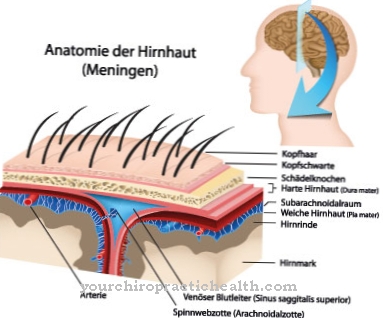The Pica syndrome is a qualitative eating disorder. Those affected consume nauseating and non-consumable substances such as clay, garbage, excrement or objects. The treatment usually corresponds to a behavioral intervention.
What is Pica Syndrome?

© Quim - stock.adobe.com
Many women experience cravings for unusual foods or combinations of foods during pregnancy. This pregnancy symptom has physical causes and is also called Picazism designated. The expression Pica syndrome based on Picazism as a term for a rare eating disorder. As part of the disease, those affected are driven by the consumption of inedible or nauseating substances.
They often ingest objects that cannot be consumed, such as scraps of paper or even objects. Long was the expression of Allotriophagy indicative of the disorder. Unlike bulimia or anorexia, pica syndrome is not a quantitative eating disorder, but is classified as a qualitative eating disorder. Usually it is a disorder with a mental cause. However, physical relationships are also known. Psychotherapy deals with treatment. Children are most often affected by it.
causes
Pica syndrome mainly affects people with mentally retarded development. People with dementia, autism or mental illnesses are also often affected by Pica syndrome. Often those affected are also extremely neglected children from families with multiple stress factors. Abuse, alcoholism and crime are observed in the family environment.
In this context, the psychoanalytic model discusses a stress disorder during the oral phase. In individual cases, however, a lack of nutritional awareness is discussed as the cause, especially in the case of mentally handicapped people. Nutritional models indicate somatic causes for the pica syndrome. Those affected are often patients with a mineral deficiency. The substances consumed would often contain exactly the mineral that those affected lack.
Symptoms, ailments & signs
Patients with pica syndrome consume substances that are not primarily on the human diet. For example, geophagy, i.e. the consumption of earth, can often be observed. Sand, stones or paper are just as often eaten. The consumption of ash, lime, plant residues and clay can be observed just as often. These four substances are most commonly associated with the somatic causes of the nutritional model.
Some patients also consume things that are considered nauseating. This includes dust and waste, but also excrement. Eating feces is known as coprophagia and can cause serious infections. The most common consequences of pica syndrome include constipation and indigestion such as bowel obstruction (ileus). In addition, poisoning can occur after the consumption of poisonous plant parts. Earth, clay, and ashes often cause infections. Persistent picacism is malnutrition that can cause iron deficiency and vitamin deficiency malnutrition.
Diagnosis & course of disease
The diagnosis of pica syndrome is made according to DSM-IV. Several criteria must be met in order to make a diagnosis. The substances consumed must be those with no significant nutritional value. Consumption must continue for at least a month and must not correspond to the age-appropriate level of development. Eating behavior must be clearly different from the culture-related norm.
In the case of simultaneous psychological disorders such as schizophrenia or cognitive disability, the eating disorder must be so serious that it requires special attention to be diagnosed. A serious disorder is present, for example, if the substances consumed cause adverse health effects or malnutrition. Other disorders should be considered in the differential diagnosis. The consumption of hair, for example, occurs mainly in the context of trichotillomania, in which the impulse control is disturbed.
Complications
Pica syndrome can lead to indigestion, which can be mild to life-threatening. Serious complications include injuries to the esophagus, stomach, and intestines that can be caused by sharp or pointed objects. Sand, earth, clay, loam, uncooked rice, parts of plants and other inedible substances cause severe constipation in some cases, which can lead to an intestinal obstruction and, more rarely, an intestinal tear. Another complication of pica syndrome is infection and inflammation. They also often develop in the gastrointestinal tract.
Poisoning, which can be associated with the consumption of toxic plants, is more common in children and adults with cognitive impairments. Some people with pica syndrome eat or lick dried paint. In this way poisoning is also possible, for example with lead. Some physical complications from pica can be fatal if not treated in a timely manner.
When should you go to the doctor?
Unusual food preferences can indicate pica syndrome. A doctor's visit is recommended if this tendency impairs well-being, for example because unhealthy food or drinks are consumed. Parents who notice this behavior in their child should consult the pediatrician.
An otherwise normal eating behavior is a clear indication of the pica syndrome. Then a doctor should be called in, who will first rule out other diseases. If the child has a reduced intelligence or suffers from psychosocial stress, a doctor's visit is particularly urgent. In addition to the pica syndrome, there may be other symptoms that need to be clarified.
In addition to the family doctor or pediatrician, child and adolescent psychologists can also be consulted. Therapeutic treatment is always necessary in pica syndrome. Adults should also consult a doctor or psychologist if there are any signs of the disorder and possibly associated with underlying psychiatric illnesses such as dementia or schizophrenia. At the latest when deficiency symptoms, poisoning and other health problems occur as a result of the disturbed food intake, a medical examination is required. Those affected should speak to their family doctor quickly and begin behavioral therapy.
Treatment & Therapy
The pica syndrome is treated causally. The therapy is considered extremely difficult and tedious. Most often, the supervising psychotherapist opts for behavioral treatment. Behavioral therapies presuppose that the disorder is based on a systematic maladjustment. This incorrect setting is deliberately unlearned again as part of the therapy. So behavior therapy is not intended to uncover the roots of the disorder.
Rather, the current behavior and view of people should be examined and corrected if necessary. Behavioral therapy guides the person affected to self-help and gives them strategies that will help them encounter their problems. The behavior analysis is at the beginning of the therapy. The behavioral conditions and the consequences of the behavior are considered. Kanfer developed the SORKC model in this regard, which sets out five principles for learning processes.
A stimulus creates the behavior. The organism reacts to the stimulus with cognitions and biological-somatic conditions, taking into account the individual biological and learning history backgrounds of the person concerned. The behavior corresponds to an observable reaction that follows the stimulus and its processing. The behavior has contingency, which means it is regularly and temporally related to the situation and the consequence.
The consequence of the behavior is a reward or punishment. When analyzing behavior using this model, the psychotherapist includes feelings and thoughts as well as physical processes or the patient's environment. The therapy goals are developed as much as possible in collaboration with the patient. In the case of children, parents are regularly advised on proper supervision and quick action in the event of poisoning.
Inpatient treatment is recommended if life is at risk. Nutritional deficiencies and other somatic causes are corrected. In the event of intestinal obstruction or other sequelae, medical intervention may be indicated.
Outlook & forecast
The further course and prognosis of pica syndrome can usually not be predicted in general. Since this is a relatively unknown and unexplored syndrome, the measures of treatment are relatively limited, with behavioral therapy or psychotherapy in particular being necessary to alleviate the symptoms. The further course also depends strongly on the time of diagnosis, with an early diagnosis always having a very positive effect on the further course of the pica syndrome.
If the pica syndrome is not treated by a doctor, in most cases there will be no self-healing. In the worst case, those affected can poison themselves and die as a result of the poisoning. Without treatment, children can develop severe psychological complaints later in life.
When treating pica syndrome, it is primarily the parents of the person affected that are asked. They must pay attention to the symptoms and act quickly if the child wants to eat an inedible object. The therapy itself can take a few months or even years, and the parents also need support. Usually, this syndrome does not reduce the life expectancy of the person affected.
prevention
Pica syndrome can be prevented to a certain extent by a stress-relieved family environment and a balanced diet.
Aftercare
In most cases, those affected with pica syndrome have very few and only very limited follow-up measures available. Those affected should first ensure a quick and, above all, early diagnosis and detection of the disease so that there are no further complications and complaints. The earlier the syndrome is recognized by a doctor, the better the further course of the disease will usually be. Self-healing cannot occur.
Most of the patients are dependent on help and treatment in a closed clinic. First and foremost, help and support from one's own family and friends has a very positive effect on the further course of the disease. In general, the trigger for pica syndrome should be prevented.
In many cases, constant monitoring by other people is necessary so that the disturbed behavior does not recur. As a rule, a general course cannot be given in pica syndrome. This disease may also reduce the life expectancy of the person affected.
You can do that yourself
In milder forms of the pica syndrome, it can help if those affected consistently suppress the unusual eating behavior or gradually reduce it. This “stop” can be practiced by spitting out the pica substance again and not continuing to consume it.
If there is a health hazard, medical and therapeutic assistance is strongly recommended. People with pica who are in therapy should concentrate on applying what they have learned in everyday life. Any kind of self-help presupposes that the person concerned is reflective and perceives the pica behavior as a problem. In children, the mentally handicapped or acutely schizophrenic, the ability to reflect is often limited, so that self-help is not always possible. In such a case, outside help can be useful.
Parents of children with pica should keep an eye on their children. Sometimes dangerous situations can be avoided if the child only plays with small parts that can be swallowed under careful observation - if at all - and otherwise has no access to such toys. Batteries, magnets, erasers and similar objects are also affected. Food such as raw rice, items for pets, washing and dish washing utensils should also be kept inaccessible. Typical outdoor risk situations arise from poisonous plants or eating sand. Parents should also praise and reward children with pica syndrome appropriately if they do not eat inedible substances.
Books on eating disorders





.jpg)


















.jpg)



